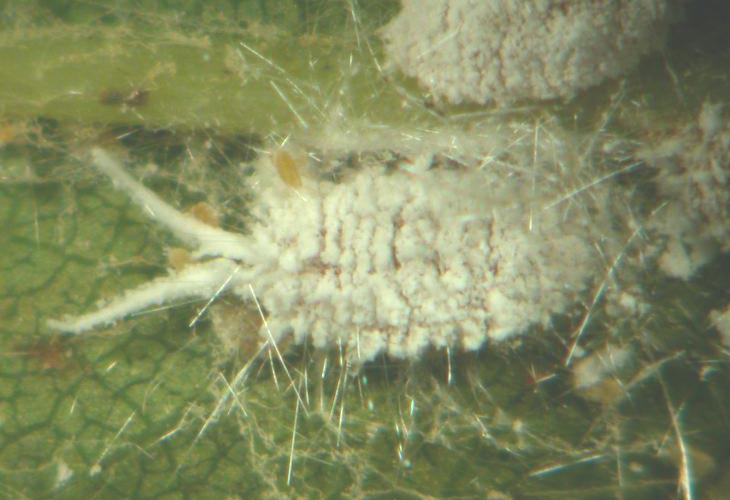
Grape mealybug, Pseudococcus maritimus (Ehrhorn)
The grape mealybug is white with a flattened,
oval shape. Filaments protrude along the perimeter of the body,
the longest protruding from the rear. First instar nymphs
overwinter in a white cottony ovisac produced by the female in the
fall. They become active in April or May, disperse over the vine,
and begin to feed at bases of shoots or pedicels of grape
clusters. Numbers are usually not high enough for damage to be
caused at this point. Adults appear in late June and ovisacs
containing eggs are deposited beneath loose bark. Young nymphs appear a few days later and
may get into fruit clusters or
feed on leaves near veins.
Adults again appear in late August. All stages may be seen on
vines in autumn. Egg-laying continues until cold weather,
but eggs that do not hatch before winter do not survive.
Populations are most likely to develop on vigorous vines with
heavy foliage that supplies greater shade and nutrition. Vine
growth is vigorous enough that the vine can tolerate this type of
injury in most cases. The problem from mealybug arises from the
honeydew, the excretory product of the insect - mostly excess sap,
containing high sugar levels. This honeydew accumulates on fruit
and foliage, supporting the growth of dark sooty mold fungus. Sooty mold
presents a cosmetic problem, mainly of concern in table grapes. In
wine grapes this is not an issue. However, high populations
feeding on and near clusters can cause clusters to drop before
harvest. Another important concern is the role in mealybugs
serving as the vector for grapevine leafroll virus.
Avoid the use of insecticides that are disruptive to poputions of
natural enemies; parasitoids often provide important natural
control of mealybugs. Where grape mealybug is expected to be
a problem, it is more severe on late-ripening varieties.
Early-maturing varieties are harvested before the second (summer)
generation has had much of an impact. Injury is usually not
severe, and natural enemies generally provide control.
Grape mealybug is by far the most common in eastern states.
In California, two additional species may present problems, the
obscure mealybug, Pseudococcus
viburni, and the vine mealybug, Planococcus ficus. When poked, grape
mealybug exudes a red fluid (ostiolar fluid), compared with clear
fluid in the other two species. Vine mealybug is more
bluntly oval and with short terminal filaments, compared with the
more elongate oval and long terminal filaments of the other two
species. Recent
work in California has shown that grape mealybug, as well as
the others, are capable of transmitting grapevine
leafroll virus.
If infestations are severe at harvest, apply a delayed dormant
spray the following spring. This may provide adequate
control; a summer spray may be needed.
See comments from California,
where an action threshold for wine grapes of 20% infested spurs
has been suggested. Applaud (buprofezin),
Venom (dinotefuran) or Assail (acetamiprid) or Admire Pro (imidacloprid) may be used. If chemical control is used, leaving a section of the vineyard unsprayed will allow a refuge
for natural enemies. See also the Practical Winery article
comparing the appearance
and biology of the three species.
Back to Virginia
Vineyard page
Back to Virginia Fruit
Page
